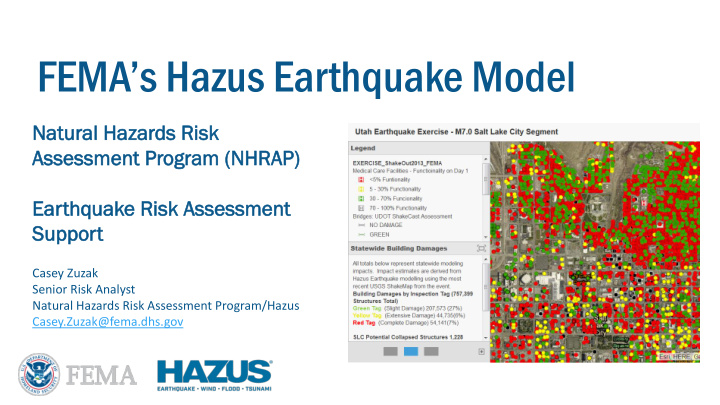



FEMA ’s Hazus Earthquake Model Na Natural tural Ha Hazar ards ds Ri Risk sk As Assessment sessment Pr Program ogram (N (NHRAP HRAP) Earthq Ea thquak uake e Ri Risk sk As Assessment sessment Su Suppor pport t Casey Zuzak Senior Risk Analyst Natural Hazards Risk Assessment Program/Hazus Casey.Zuzak@fema.dhs.gov
FEMA NHRAP/Hazus Earthquake Risk Assessment Support • Natural Hazards Risk Assessment Program • Hazus Earthquake Model Enhancements • Catastrophic Events Scenario Planning • NHRAP Liaison Role for Real Response Events • FEMA/USGS NEIC TwoPager Product NHRAP/Hazus EQ
Natural Hazards Risk Assessment Program • Newly created program under the FEMA HQ Risk Management Directorate in 2017 • Goal: Provide risk assessment data, tools, analyses, and methodological guidance to support FEMA programs and partners in the development of risk communication for all phases of emergency management. • NHRAP closely coordinates EQ risk assessment efforts with the USGS National Earthquake Information Center (NEIC) • FEMA’s Hazus Program is now managed by the Natural Hazards Risk Assessment Program • Program Manager: Jesse Rozelle • Senior Risk Analyst: Casey Zuzak NHRAP/Hazus EQ
Hazus Earthquake Loss Estimation Model Overview • Hazus is FEMA’s natural hazards loss estimation tool for earthquakes, floods, hurricane winds, and tsunamis • Hazus was first released in 1997 to standardize loss estimation methodology in the federal government • It has an open and transparent methodology, vetted by the scientific community, and made freely available to the public • Hazus has been highlighted by the World Bank and the European Union as one of the leading loss estimation models in the world • Used extensively for Utah Wasatch Front Catastrophic Planning NHRAP/Hazus EQ
Hazus Model Supported Hazards Earthquake Hurricane Wind & Storm Surge Riverine & Coastal Flooding Tsunami (near & distant source) NHRAP/Hazus EQ
Hazus Model Development Timeline
A check mark indicates the hazard module performs some type of analysis (produces output) for that loss or damage category; that analysis should not be assumed to be the same as other hazards checked for the same category, nor should it be assumed to be comprehensive.
Hazus Spectrum Method for Buildings Damages NHRAP/Hazus EQ
Construction Type Specific Collapse Rates NHRAP/Hazus EQ
Probability Estimation of Casualty Levels NHRAP/Hazus EQ
Recent Improvements to the Hazus EQ Model • Direct USGS NEIC ShakeMap Integration Feed • Directly Imports high resolution grid.xml format for PGA, PGV, PSA 1.0s, PSA 0.3s • Recent real events in proximity to your study area show up automatically in the GUI for import NHRAP/Hazus EQ
Recent Improvements to the Hazus EQ Model • USGS Vs30 (time-averaged shear wave velocity to 30M depth) site soil Characterization added as the default source for probabilistic scenarios. https://earthquake.usgs.gov/data/vs30/ • Follows the recently released FEMA P-366 Methodology “Hazus Estimated Annualized Earthquake Losses for the United States (April 2017)” https://www.fema.gov/media- library/assets/documents/132305 • Hazus EQ model source code shared with USGS NEIC for additional review and methodology enhancement suggestions NHRAP/Hazus EQ
Catastrophic Planning – Wasatch Front • Hazus EQ scenarios used extensively for planning efforts in the Wasatch Front. • Developed in close coordination with Bob Carey and others at Utah DEM. • 2018 updates to model currently underway by FEMA Region 8 team • For any questions contact zachary.lamb@fema.dhs.gov NHRAP/Hazus EQ
Catastrophic Planning – Wasatch Front 2018 Update • 7.0 M earthquake on Salt Lake Segment of Wasatch Fault in December • Affects 80% of the population of Utah • 2,978 Fatalities ( ▲ 476) • Injured: • 9,168 require hospitalization ( ▼ 248) • 29,298 with minor injuries ( ▲ 1,774) • Displaced Population: • 88,090 households displaced ( ▲ 1,758) • 54,514 people seek temporary shelter in public shelters ( ▲ 653) 55,742 buildings significantly damaged ( ▼ 500) 331 bridges impassible and/or significantly damaged ( ▲ 191) • 443K households without potable water on day 1 ( ▲ 64K); 339K on day 90 ( ▲ 52K) • 251K households without power on day 1 ( ▼ 131K); 22K on day 30 ( ▼ 8K) • 29 million tons of debris generated ( ▲ 8M); 1.2 million truckloads at 25 tons/truck ( ▲ 369K) Questions contact: zachary.lamb@fema.dhs.gov • Total economic impact: >$79 billion direct loss ( ▲ $49B) (increase ▲ or decrease ▼ from 2012 Hazus) NHRAP/Hazus EQ
Catastrophic Planning – Hazus Earthquake Loss Atlas • Currently developing a Hazus Earthquake Loss Atlas for public viewing. • Based on catastrophic planning Shake Map scenarios developed by the USGS NEIC. • Includes a full suite of Hazus EQ loss estimation results for each ShakeMap scenario. NHRAP/Hazus EQ
FEMA NHRAP Earthquake Response Liaison to USGS Earthquake Information Timeline 0 5min 10-20min 40min 1hr 2-3 hrs 24hrs Did You Feel It? NHRAP/Hazus EQ
NHRAP Catastrophic Event Disaster Response Support Official NHRAP and Hazus Program Loss Estimates • When Real Earthquakes Occur • NHRAP disaster operations team co locates at the USGS NEIC • Official FEMA Hazus Earthquake runs are generated, given to NEIC SME’s for QA/QC review before public release • TwoPager report and FEMA earthquake journal data feeds are generated (2-3 hours post event) • TwoPager report is released by USGS NEIC NHRAP/Hazus EQ
FEMA NHRAP Earthquake Response TwoPager USGS OnePAGER (USGS Model) FEMA/USGS TwoPAGER (Hazus) NHRAP/Hazus EQ
Questions/Comments? FEMA’s Hazus Program is now managed by the Natural Hazards Risk Assessment Program under FIMA’s Risk Management Directorate. For any questions or comments regarding Hazus or the NHRAP please feel free to contact FEMA-NHRAP@fema.dhs.gov. Jesse Rozelle Program Manager Natural Hazards Risk Assessment Program/Hazus Jesse.Rozelle@fema.dhs.gov Casey Zuzak Senior Risk Analyst Natural Hazards Risk Assessment Program/Hazus Casey.Zuzak@fema.dhs.gov NHRAP/Hazus EQ
Recommend
More recommend